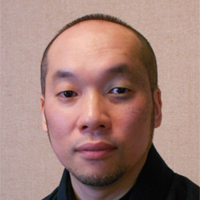Box with design in raised makie. “Hiya (Angels ladder)”
- Lacquerware
- Presented in 2022
- H 20.7 x W 26.8 x D 15.3 cm
- Contact for Price
"Hiya" means sunlight shining through the clouds. It is a phenomenon where rays of sunlight pour down to the ground through the break in the clouds when the sun is hiding behind the clouds. In meteorological terms, these are called "crepuscular rays", and in other words they are sometimes called the "angel's ladder".
I utilized the form of the cover of the box to express drifting clouds and applied matte black raised makie. Rays of sunlight can be seen shining through the break of clouds in the middle. On the sides of the box, I expressed several angel's ladders coming through the clouds using gold makie and raden. If you see all sides of the box, you can see misty rain and a rainbow after the rain on the back side. On the inner side of the cover, the night sky with a hazy moon is designed, and in the inside of the box is a spider's web with night dew shining under the moonlight.
Sunlight shining through the clouds, a rainbow, a spider's web shining with night dew; there seems to be a culture to find various spiritual meanings in such things everywhere at all times.
By making this piece, I found myself understanding this feeling.
| Category | Lacquerware |
|---|---|
| Year Presented | 2022 |
| Dimensions | H 20.7 x W 26.8 x D 15.3 cm |
| Materials | dry lacquer (partially wood based), gold, pearl oyster, south sea abalone shells (known as tamamushi (jewel beetle) shells), platinum, silver, pigments |
| Exhibition | The 69th Japan Traditional Kōgei Exhibition |
| Artist Signature | Signature on box and piece |
| Notes | Comes with box |
-
Dry lacquer
For works of dry lacquer (kanshitsu), first a clay form is created and plaster is used to take a mold of the form. Next, repeated layers of hemp cloth and lacquer are applied to the mold until they are built up to the desired thickness. Finally, the mold is removed and additional coats of lacquer are applied to finish the piece. The hemp fibers are strengthened when the lacquer bonds with them, making dry lacquer an excellent technique for creating sturdy forms with a significant degree of freedom.
-
Maki-e
Maki-e (literally “sprinkled pictures”) is a representative lacquerware technique that originated in Japan around 1,200 years ago. Maki-e is done by painting lacquer motifs on the surface of a piece using a fine brush and then sprinkling gold powder onto the lacquer before it hardens, producing luxurious decorations.
-
Metal sheet inlay
Metal sheet inlay (hyōmon) is a technique that involves cutting shapes out of thin sheets of gold, silver, or other metals to create an inlay motif.
-
Mother-of-pearl inlay (Raden)
Mother-of-pearl inlay (Raden) is a decorative technique that uses the iridescent inner layer of abalone shell, turban shell, pearl oyster shell, or other mollusk shells. The technique came to Japan from China 1,300 years ago, and pieces featuring mother-of-pearl inlay are included among the artifacts at the Shōsōin Repository in Nara.
Keiji Onihira

I create my artwork with lacquer, gold, powder, mother-of-pearl, using various makie techniques. Many new types of lacquer and pigments are being developed these days. I try to use these new materials and techniques within the traditional artwork, as I believe this will create a new tradition. With traditional lacquerware at the base, I want to try various motifs and themes to produce artwork that create a special little world or atmosphere.



